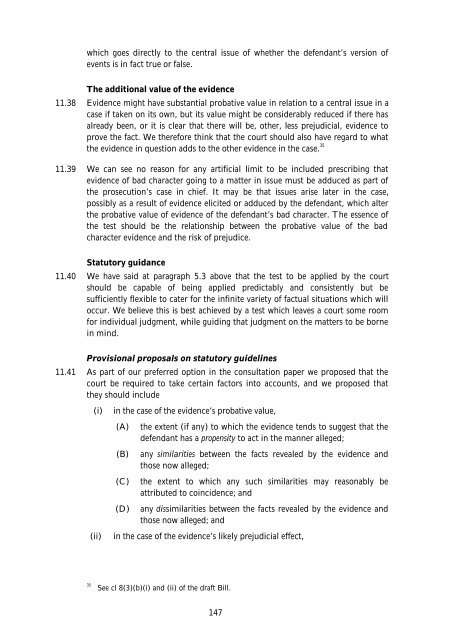Evidence of Bad Character in Criminal ... - Law Commission
Evidence of Bad Character in Criminal ... - Law Commission
Evidence of Bad Character in Criminal ... - Law Commission
Create successful ePaper yourself
Turn your PDF publications into a flip-book with our unique Google optimized e-Paper software.
which goes directly to the central issue <strong>of</strong> whether the defendant’s version <strong>of</strong><br />
events is <strong>in</strong> fact true or false.<br />
The additional value <strong>of</strong> the evidence<br />
11.38 <strong>Evidence</strong> might have substantial probative value <strong>in</strong> relation to a central issue <strong>in</strong> a<br />
case if taken on its own, but its value might be considerably reduced if there has<br />
already been, or it is clear that there will be, other, less prejudicial, evidence to<br />
prove the fact. We therefore th<strong>in</strong>k that the court should also have regard to what<br />
the evidence <strong>in</strong> question adds to the other evidence <strong>in</strong> the case. 35<br />
11.39 We can see no reason for any artificial limit to be <strong>in</strong>cluded prescrib<strong>in</strong>g that<br />
evidence <strong>of</strong> bad character go<strong>in</strong>g to a matter <strong>in</strong> issue must be adduced as part <strong>of</strong><br />
the prosecution’s case <strong>in</strong> chief. It may be that issues arise later <strong>in</strong> the case,<br />
possibly as a result <strong>of</strong> evidence elicited or adduced by the defendant, which alter<br />
the probative value <strong>of</strong> evidence <strong>of</strong> the defendant’s bad character. The essence <strong>of</strong><br />
the test should be the relationship between the probative value <strong>of</strong> the bad<br />
character evidence and the risk <strong>of</strong> prejudice.<br />
Statutory guidance<br />
11.40 We have said at paragraph 5.3 above that the test to be applied by the court<br />
should be capable <strong>of</strong> be<strong>in</strong>g applied predictably and consistently but be<br />
sufficiently flexible to cater for the <strong>in</strong>f<strong>in</strong>ite variety <strong>of</strong> factual situations which will<br />
occur. We believe this is best achieved by a test which leaves a court some room<br />
for <strong>in</strong>dividual judgment, while guid<strong>in</strong>g that judgment on the matters to be borne<br />
<strong>in</strong> m<strong>in</strong>d.<br />
Provisional proposals on statutory guidel<strong>in</strong>es<br />
11.41 As part <strong>of</strong> our preferred option <strong>in</strong> the consultation paper we proposed that the<br />
court be required to take certa<strong>in</strong> factors <strong>in</strong>to accounts, and we proposed that<br />
they should <strong>in</strong>clude<br />
(i) <strong>in</strong> the case <strong>of</strong> the evidence’s probative value,<br />
(A) the extent (if any) to which the evidence tends to suggest that the<br />
defendant has a propensity to act <strong>in</strong> the manner alleged;<br />
(B) any similarities between the facts revealed by the evidence and<br />
those now alleged;<br />
(C) the extent to which any such similarities may reasonably be<br />
attributed to co<strong>in</strong>cidence; and<br />
(D) any dissimilarities between the facts revealed by the evidence and<br />
those now alleged; and<br />
(ii) <strong>in</strong> the case <strong>of</strong> the evidence’s likely prejudicial effect,<br />
35 See cl 8(3)(b)(i) and (ii) <strong>of</strong> the draft Bill.<br />
147

















